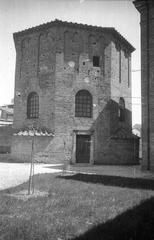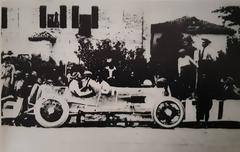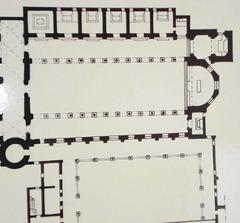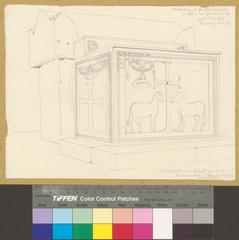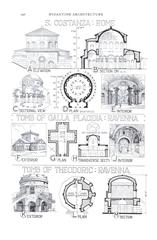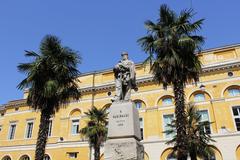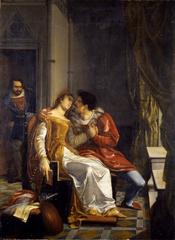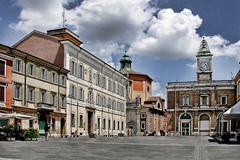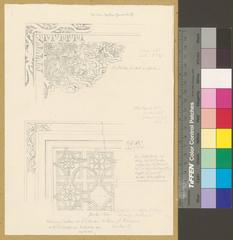Quadrarco di Braccioforte: Visiting Hours, Tickets, and Historical Guide to Ravenna’s Hidden Gem
Date: 03/07/2025
Introduction: The Quadrarco di Braccioforte and Its Place in Ravenna
In the heart of Ravenna, Italy—a city renowned for its UNESCO-listed mosaics and rich cultural tapestry—the Quadrarco di Braccioforte stands as a tranquil sanctuary, steeped in layers of spiritual, artistic, and literary significance. Dating back to at least the 9th century CE, this quadrangular oratory is not only an architectural testament to Ravenna’s early Christian past but also a site intricately linked to the memory of Dante Alighieri, Italy’s Supreme Poet. Nestled within the pedestrianized “Zone of Silence,” the Quadrarco offers a peaceful retreat for reflection and a key stop along the city’s cultural pilgrimage route, which includes Dante’s Tomb and the Basilica di San Francesco (Ravenna Tourism).
This guide provides a comprehensive overview of the Quadrarco’s history, legends, artistic features, visitor information, and tips for making the most of your visit to Ravenna’s historic core.
Table of Contents
- Introduction
- Historical Overview and Origins
- The Legend of “Braccioforte”
- Medieval Evolution and Artistic Features
- The Quadrarco and Dante’s Legacy
- Key Architectural and Artistic Highlights
- Conservation and Preservation
- Practical Visitor Information
- Getting There and Nearby Attractions
- Photography Tips
- Frequently Asked Questions (FAQ)
- Final Recommendations
- References and Sources
Historical Overview and Origins
The Quadrarco di Braccioforte traces its origins to at least the 9th century, as mentioned by historian Andrea Agnello. Originally, the oratory was connected by portico to the now-lost Basilica of San Francesco, serving as a site of Christian worship and reflection (Comune di Ravenna). Over the centuries, it has evolved architecturally and functionally, adapting to shifting religious and civic contexts.
Its location in the so-called “Zone of Silence”—a pedestrian sanctuary designed for contemplation—places it at the center of Ravenna’s historic and spiritual landscape, closely associated with Dante’s final resting place (ilromagnolo.info).
The Legend of “Braccioforte”
The name “Braccioforte” (“Strong Arm”) derives from a local legend: two fervent worshippers, seeking divine intervention, swore an oath invoking the “strong arm” of Christ at the very spot where the oratory stands (vivadante.it). Though the original image of Christ no longer survives, this legend endows the Quadrarco with ongoing spiritual resonance, making it a symbolic place of faith and supplication.
Medieval Evolution and Artistic Features
Throughout the Middle Ages and Renaissance, the Quadrarco’s role expanded. Its garden houses two 5th-century marble sarcophagi—originally crafted for prominent citizens and later reused by the noble Pignata and Traversari families (vivadante.it). These sarcophagi, adorned with early Christian iconography such as the Chi-Rho and stylized vines, reflect the continuity between Ravenna’s late antique, medieval, and modern identities.
A notable 20th-century addition is the wrought-iron fence designed by Umberto Bellotto in 1921, commemorating the 600th anniversary of Dante’s death. The rediscovery of its original prototypes in 2025 has further highlighted the Quadrarco’s artistic legacy (ravenna24ore.it). A majestic oak, planted by Giosuè Carducci, stands as a living tribute to Dante’s enduring influence (turismo.ra.it).
The Quadrarco and Dante’s Legacy
The Quadrarco is intimately bound to Dante Alighieri’s story. After Dante’s death in 1321, his remains were enshrined in Ravenna. During World War II, to protect them from bombings, Dante’s bones were secretly buried under a grassy mound in the Quadrarco’s garden—a site now marked by a poignant plaque (ilromagnolo.info). This act of preservation symbolizes the site’s role as a guardian of cultural memory.
The daily tolling of the “Campana di Dante” (Bell of Dante), donated by Italian municipalities in 1921, is a living ritual that honors the poet each evening, echoing through the Zone of Silence and reinforcing the Quadrarco’s status as a place of remembrance (turismo.ra.it).
Key Architectural and Artistic Highlights
Layout and Structure
The Quadrarco features a modest oratory opening onto a serene, walled garden shaded by mature trees. Its covered portico, supported by simple columns, is emblematic of Ravenna’s early Christian architecture and fosters a contemplative ambiance (Heroes of Adventure).
5th-Century Sarcophagi
The two marble sarcophagi are adorned with Christian symbols and geometric motifs, illustrating the evolution from pagan to Christian art. Later inscriptions and heraldic symbols by the Pignata and Traversari families add medieval context (Comune di Ravenna).
The Green Mound
At the garden’s center, a grassy mound commemorates the temporary sanctuary of Dante’s remains during World War II (Comune di Ravenna). This subtle feature underscores the Quadrarco’s role as a guardian of heritage.
Wrought-Iron Fence and Oak Tree
The ornate fence by Umberto Bellotto and the oak tree planted by Carducci both serve as enduring symbols of Ravenna’s artistic and literary legacy (turismo.ra.it).
Conservation and Preservation
Extensive restoration efforts in the 20th and 21st centuries have stabilized the Quadrarco’s ancient masonry, conserved the sarcophagi, and enhanced the garden’s landscaping, ensuring accessibility and historical integrity for future generations (Comune di Ravenna).
Practical Visitor Information
Visiting Hours and Tickets
- Hours: The Quadrarco di Braccioforte is generally open daily from 10:00 AM to 6:00 PM, but hours may vary seasonally or during special events. Check the official Ravenna tourism website for updates.
- Admission: Entrance is free; donations for preservation are welcome. Combined tickets with Dante’s Tomb and nearby museums are often available.
Accessibility
The site is wheelchair accessible, with paved or gravel paths and ramps. Some cobblestone areas require caution. Families and visitors with mobility needs can easily enjoy the site, with nearby restrooms and benches available.
Guided Tours and Events
Guided tours can be arranged through local tourism offices and provide deeper insights into the Quadrarco’s history and art. The site occasionally hosts cultural events, such as poetry readings and commemorations, particularly on dates significant to Dante (evendo.com).
Getting There and Nearby Attractions
The Quadrarco is centrally located:
- On foot: A 15-minute walk from Ravenna railway station.
- By public transit: Buses 4 and 7 stop near Piazza San Francesco.
- By car: Park outside restricted traffic zones (ZTL) for convenient access.
Nearby highlights include:
- Dante’s Tomb
- Basilica di San Francesco
- Basilica di San Vitale
- Mausoleum of Galla Placidia
- Piazza del Popolo
- Domus dei Tappeti di Pietra
Photography Tips
The Quadrarco offers exceptional opportunities for photography:
- Best time: Early morning or late afternoon for soft natural light.
- Highlights: The wrought-iron fence, oak tree, sarcophagi, and tranquil garden.
- Restrictions: Flash and tripods are generally prohibited; always respect signage.
Frequently Asked Questions (FAQ)
Q: What are the Quadrarco di Braccioforte opening hours?
A: Usually 10:00 AM to 6:00 PM daily, but confirm on official sites for seasonal changes.
Q: Is there an admission fee?
A: Admission is free; donations are appreciated. Combined tickets for nearby sites may be available.
Q: Is the site accessible for visitors with disabilities?
A: Yes, the site is accessible; some cobblestone paths may require attention.
Q: Are guided tours available?
A: Yes, tours can be booked via the tourism office or on-site.
Q: Can I take photographs at the site?
A: Yes, but avoid flash and tripods to protect the site.
Final Recommendations
The Quadrarco di Braccioforte embodies Ravenna’s unique blend of spirituality, history, legend, and art. Its serene atmosphere, ancient monuments, and evocative rituals—especially the evening toll of the Campana di Dante—make it a must-see for anyone exploring Ravenna’s heritage. The site’s free admission, accessibility, and proximity to other landmarks ensure it is easily included in any itinerary.
For the most rewarding experience, check current hours and events, consider joining a guided tour, and explore multimedia resources like the Audiala app for expert audio commentary and up-to-date visitor information.
References and Sources
- Ravenna Tourism - Quadrarco di Braccioforte
- Comune di Ravenna - Tomba di Dante e Quadrarco di Braccioforte
- Zone of Silence: Quadrarco di Braccioforte
- ReadySetItaly - What to See in Ravenna
- TripExpert - Dante’s Tomb and Quadrarco of Braccioforte
- Evendo.com - Quadrarco di Braccioforte
Images for this article should feature the Quadrarco’s arches, gardens, and the Campana di Dante bell, with alt tags such as “Quadrarco di Braccioforte visiting hours” and “Ravenna historical sites.”
